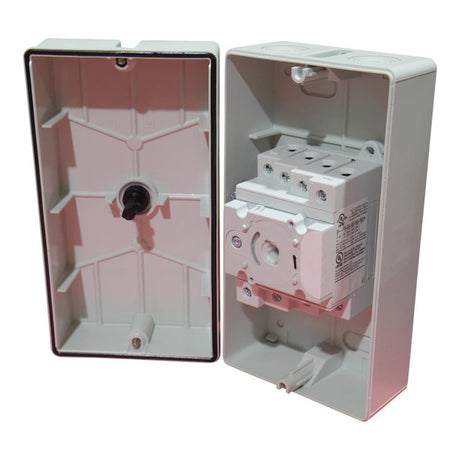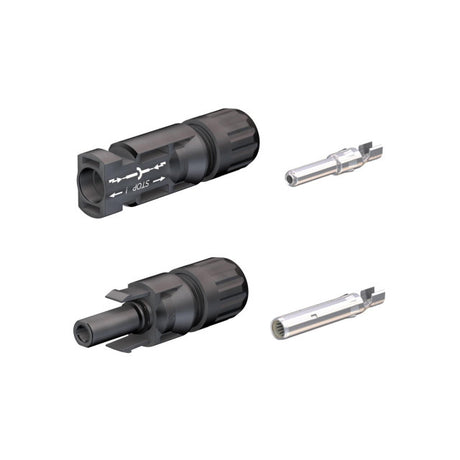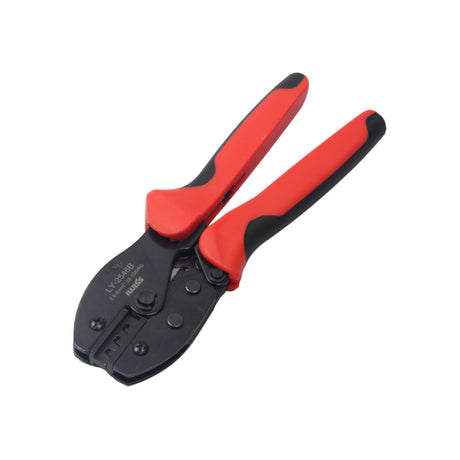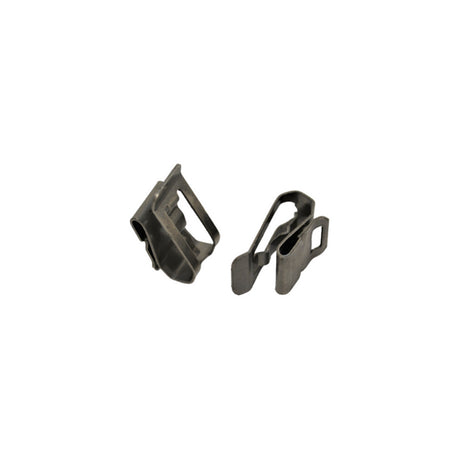Tigo
$54.29$59.99Unit price /UnavailablePortable Sun LLC
84in 1/0 AWG Battery to Inverter Cables | Black and Red
$87.88Unit price /Unavailable- 18% off
Midnite Solar
Midnite Solar Battery Busbar | 280 Amp | 5 5/16 Studs | 6 Auxiliary Slots | MNBIGBUSBAR
$89.99$109.24Unit price /Unavailable - 13% off
Midnite Solar
Midnite Solar Lightning and Surge Arrestor | 600DC | MNSPD-600
$89.99$95.67Unit price /Unavailable- 28% off
Midnite Solar
Midnite Solar Lightning and Surge Arrestor | 300AC | MNSPD-300-AC
$89.99$95.67Unit price /UnavailableRuixu
Ruixu 6 Slot Battery Cabinet | Wheels & Busbar Included | Pre-assembled
$559.00$699.00Unit price /Unavailable- 27% off
Midnite Solar
MidNite Solar MNEPV15-600-2PP Din Rail Mount Breaker
$45.99$63.00Unit price /Unavailable- 25% off
Midnite Solar
$599.99$799.99Unit price /Unavailable Midnite Solar
MidNite Solar MNLBC-W250 Lithium Battery Combiner
$539.39$639.00Unit price /UnavailablePortable Sun LLC
36in 4/0 AWG Battery to Inverter Cables | Black and Red
$92.34$123.44Unit price /Unavailable- 16% off
Midnite Solar
Midnite Solar MNBCB 1000/50 Battery Combiner
$793.80$1,134.00Unit price /UnavailableTigo
$165.75$189.99Unit price /UnavailablePortable Sun LLC
72in 4/0 AWG Battery to Inverter Cables | Black and Red
$105.00$123.44Unit price /UnavailableTigo
Tigo Cloud Connect Advanced - Data Logger Kit: TAP, Din Rail PS, Outdoor box (CCA TAP Kit)
$329.39$399.99Unit price /Unavailable- 13% off
Ruixu
Ruixu Lithi2-16 Battery to Inverter Cables | Black + Orange | 1/0 AWG cables - 3/8" Lug
$140.00$160.00Unit price /Unavailable - 9% off
Ruixu
Lithi2-16 Battery Cable Connector | Black + Orange | for 1/0 AWG, 2AWG, or 4AWG cable
$24.00Unit price /UnavailableDiscover Energy Systems
Discover Energy Systems 950-0067 HELIOS ESS – Generic Conduit Box
$189.00$199.00Unit price /UnavailableDiscover Energy Systems
Discover Energy 950-0070 HELIOS ESS – 2/0 Battery to Inverter Cable Set
$220.00$239.00Unit price /Unavailable
What Are Solar System Components?
Solar system components are parts that make up a solar installation. A basic setup includes solar panels, an inverter (or several microinverters), solar system hardware (mounting and racking equipment), and electrical components.
That said, some systems may require additional parts. For example, if you want to store excess solar energy for later use, you need a solar battery, preferably with a charge controller.
While they have different roles, all the solar system parts are equally important for safe and efficient energy transfer.
Essential Components of a Solar System
These are the essential components of a solar system:
- Solar panels. The three main types are thin-film, monocrystalline, and polycrystalline panels. These parts capture sunlight and generate direct current (DC) electricity.
- Inverters. These devices convert DC electricity into usable alternating current (AC) electricity. There are string, hybrid, and microinverters.
- Mounting and racking equipment. Mounts securely attach panels to the roof (roof mounts) or the ground (ground mounts), ensuring stability and exposure to sunlight. Meanwhile, racks provide the structural framework that positions panels.
- Wiring and electrical components. Wires connect panels to other components, while fuses protect them from power surges. Connectors ensure water-resistant connections, conduits protect and organize cables, and junction boxes house and safeguard solar system wiring connections.
Now, let’s look into crucial off-grid solar system components:
- Solar battery. It stores energy during peak sun hours for use at night, on cloudy days, or during power outages.
- Charge controller. It prevents the battery from overcharging, preserving its health and prolonging its lifespan.
Solar components can also include monitoring devices for assessing the system’s efficiency and performance, as well as surge protectors, lightning rods, and arrestors for solar panel lightning protection.
4 Major Benefits of Using High-Quality System Components
Some of the major benefits of using high-quality system components include enhanced efficiency, long-term durability, improved safety, compatibility, and scalability.
Let’s examine them in more detail:
1. Enhanced Solar System Efficiency
Solar power system components made of high-quality materials are more efficient at capturing sunlight and turning it into usable electricity. This means you can enjoy the benefits of producing your own renewable energy to the fullest, even if you choose to live off the grid.
2. Long-Term Durability
High-quality solar equipment has a longer lifespan and better resistance to harsh weather conditions, including heat, snow, wind, and hail. In other words, choosing the components wisely can bring you years of clean energy with minimal maintenance and maximum savings.
3. Improved Safety
With a solid inverter, good wiring, and adequate protection, you don’t have to worry about short circuits and fire hazards. Investing in quality solar system components means investing in safety, reliability, and peace of mind for you and your family.
4. Compatibility and Scalability
Solar panels have a long lifespan—up to 30 years—and your energy needs may grow in the meantime. That’s why you should consider scalable equipment, as it allows you to easily expand your system by adding more components without major upgrades or replacements.
How to Pick the Right Components for Your Solar Power System
To pick the right components for your solar power system, you need to consider their compatibility with your system, quality, energy efficiency, size, as well as brand reputation and warranty.
Here’s a breakdown of all these factors:
1. Compatibility With Your Solar System
The solar components you choose to add to your setup need to be compatible with it. The inverter must match the voltage and capacity of the panels, and the battery storage has to meet the system’s energy needs. Besides that, the mounting and racking equipment need to be sized to fit the solar panel dimensions.
2. Quality
The better the quality of the solar equipment, the longer it will last. While this means the initial costs of solar panels and other parts may be higher, it also leads to fewer maintenance expenses and greater long-term savings.
3. Energy Efficiency
Solar panels’ efficiency should match your energy needs. Therefore, start by determining how much solar energy you need. Do you intend to use it to cover part of your expenses or power your entire home with it? The answer to this question will bring you closer to the right choice of panels.
4. Brand Reputation and Warranty
Take your time to look into different brands and compare their warranty coverages. The longer the warranty, the more confident the manufacturer is in their product.
5. Size
Solar panel sizes vary, and the one you need depends on your installation space. If it’s limited, you should go with smaller yet higher-efficiency panels.
Solar System Components FAQ
1. What are the basic components of a solar system?
The basic components of a solar system are solar panels, an inverter (or several microinverters), wiring, electrical components, mounting equipment, and a racking system. For off-grid living, you also need a battery and a charge controller.
2. How do I choose the right cables and connectors for my system?
To choose the right cables and connectors for your system, make sure they’re rated for the system’s voltage and current. For outdoor installations, you should use UV-resistant and weatherproof cables to prevent damage.
3. Do I need a battery cabinet for my solar setup?
You need a battery cabinet for your solar setup if you’re using battery storage. It provides a safe and weatherproof space to house your battery, protecting it from environmental and mechanical damage, as well as temperature fluctuations.
4. What is the purpose of a conduit box in a solar system?
The purpose of a conduit box in a solar system is to organize and protect its electrical wiring from physical and weather-induced damage. It also ensures the wiring is properly insulated, minimizing the risk of electrical hazards.
5. How do I manage and organize solar wiring efficiently?
To manage and organize solar wiring efficiently, you should use conduits to safeguard and organize cables and junction boxes to house and protect the wiring. You can also label cables and secure them with clips or ties to prevent tangling.









































